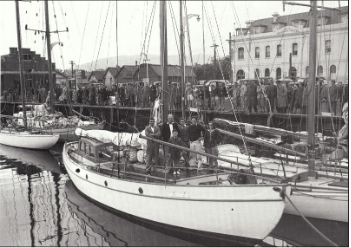Historic Australian sculpture reveals colonial controversy
This enigmatic work was recently donated to the museum and is now on display to the public.
Functionally plumbed, the 1.3 metre tall statue is as extraordinary as it is mysterious. Since its arrival, Maritime Museum Tasmania staff and volunteers have been busy piecing together the evidence to determine who the statue depicts, why the statue was commissioned, and by whom.
While certainty about the identity of the fountain figure remains elusive, there is a compelling case that it may represent Lieutenant-Governor George Arthur. The provocative nature of the work suggests a political statement of contempt rather than a whimsical garden feature.
If the statue does depict Lieutenant-Governor George Arthur, then the investigation points towards a window in time it was commissioned, and therefore who may have made it: between May 1835 and early 1836, during the period when stonemason Daniel Herbert was working on the Ross Bridge.
William Kermode, an extremely successful merchant in the colony at the time is suspected to be responsible for commissioning the fountain figure. Evidence suggests that few individuals possessed the animosity, resources, and opportunity to authorise such a contemptuous political statement.
"This extraordinary work challenges our perceptions of colonial art and political expression," says Maritime Museum Tasmania President Chris Tassell. "Maritime Museum Tasmania is pleased to be able to present this remarkable and provocative sculpture and we invite the public to join us in unravelling the mysteries of Australia's earliest known free-standing full-length statue."
In March 2025, visitors to the Maritime Museum were treated to a rare sight: a live conservation treatment carried out in the gallery.
Led by Dr Evan Tindal and Marica Mucic from the University of Melbourne’s Grimwade Conservation Services, the project involved careful removal of old adhesive, precision pinning, and reattachment of the missing parts using conservation-grade materials. Traditional techniques were on show — including the use of uncooked rice to support the curing hand — as well as modern stabilisation and inpainting to blend and protect the repairs.
Visitors were invited to observe the work and speak with the conservators, gaining rare insight into the science and skill behind object conservation.
The project was made possible through the generous support of The Copland Foundation and reflects the Museum’s commitment to preserving Tasmania’s maritime heritage.
The enigmatic sculpture, now fully restored and structurally sound, is on display in Maritime Museum Tasmania's Carnegie Gallery and offers a unique glimpse into the complexities of colonial Tasmania. Guests are encouraged to visit the museum's display and engage in the ongoing conversation about the origins and significance of this remarkable piece.








